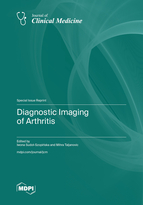Diagnostic Imaging of Arthritis
A special issue of Journal of Clinical Medicine (ISSN 2077-0383). This special issue belongs to the section "Immunology".
Deadline for manuscript submissions: closed (15 June 2022) | Viewed by 69828
Special Issue Editors
Interests: radiography; ultrasonography; magnetic resonance imaging; DECT; rheumatic diseases; connective tissues diseases; spondyloarthritis; inflammatory arthritis; juvenile arthritis
Special Issue Information
Dear Colleagues,
Over the past decade, imaging of arthropathies, including both noninflammatory and inflammatory arthritis, has evolved rapidly. This is particularly due to the constant technological improvements in cross-sectional modalities; new developments in immunology, molecular biology, genetics, and histopathology; as well as interdisciplinary cooperation resulting in the application of imaging to both clinical research and everyday practice.
The many developments in imaging technology include WB-MRI, advances for muscle imagining, advances in MRI after joint arthroplasty, DECT, more sensitive doppler techniques, higher frequencies of transduces, shear wave elastography in the case of ultrasonography, and nuclear imaging. There have also been advances in quantitative morphologic assessment of the biochemical composition of cartilage in MRI, crystal burden in DECT, vascularity in DCE-MRI and ultrasonography, and bone mineral density in DEXA, CT, ultrasound, and MRI, as well as in semiquantitative assessments. Various other ongoing developments, including musculoskeletal applications of artificial intelligence, are also taking place.
This Special Issue aims to present these new frontiers of “Diagnostic Imaging in Arthritis”.
We invite contributions from experts on imaging in arthropathies, both inflammatory and noninflammatory, in adults and juveniles in order to present recent scientific achievements and update the scientific literature on this topic.
Prof. Dr. Iwona Sudoł-Szopińska
Prof. Dr. Mihra Taljanovic
Guest Editors
Manuscript Submission Information
Manuscripts should be submitted online at www.mdpi.com by registering and logging in to this website. Once you are registered, click here to go to the submission form. Manuscripts can be submitted until the deadline. All submissions that pass pre-check are peer-reviewed. Accepted papers will be published continuously in the journal (as soon as accepted) and will be listed together on the special issue website. Research articles, review articles as well as short communications are invited. For planned papers, a title and short abstract (about 100 words) can be sent to the Editorial Office for announcement on this website.
Submitted manuscripts should not have been published previously, nor be under consideration for publication elsewhere (except conference proceedings papers). All manuscripts are thoroughly refereed through a single-blind peer-review process. A guide for authors and other relevant information for submission of manuscripts is available on the Instructions for Authors page. Journal of Clinical Medicine is an international peer-reviewed open access semimonthly journal published by MDPI.
Please visit the Instructions for Authors page before submitting a manuscript. The Article Processing Charge (APC) for publication in this open access journal is 2600 CHF (Swiss Francs). Submitted papers should be well formatted and use good English. Authors may use MDPI's English editing service prior to publication or during author revisions.
Keywords
- arthropathies
- arthritis
- arthralgia
- diagnostic imaging
- radiography
- ultrasonography
- magnetic resonance imaging
- computer tomography
- DECT
- PET
- SPECT
- nuclear imaging
- artificial intelligence.








